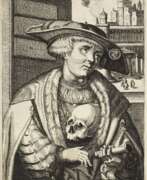Medalists 16th century


Jakob Binck / Bink, a German artist, was skilled in engraving, etching, painting, and medal making. He worked for various courts in Northern Europe, including the Danish court, and resided in Antwerp. Binck's artistic style resembled that of the Little Masters group. While it is believed he may have been a pupil of Dürer, his early residence in Italy casts doubt on this assumption. Binck's known paintings are primarily portraits, known for their accurate drawing and artistic taste.


Jean Duvet was a French Renaissance goldsmith and engraver, now best known for his engravings. He was the first significant French printmaker. He produced about seventy-three known plates, that convey a highly personal style, often compared to that of William Blake, with very crowded compositions, a certain naive quality, and intense religious feeling. According to Henri Zerner, his work has a "freedom and immediacy that have no equivalent in Renaissance printmaking".


Francesco Francia, also known as Francesco Raibolini, was an Italian painter, goldsmith, and medallist from Bologna. He began his career in the late 15th century and collaborated with artists like Lorenzo Costa, drawing inspiration from the styles of Ercole de' Roberti, Perugino, and Raphael.
Francia ran a successful workshop and trained notable artists such as Marcantonio Raimondi and Ludovico Marmitta. While it was once rumored that Raphael's work caused him to die of depression, their friendship has since debunked this claim.
Francesco Francia passed away in Bologna, and his sons, Giacomo Francia and Giulio Francia, also became artists.


Quentin Matsys (Dutch: Quinten Matsijs), a Flemish painter born around 1466 in Leuven, is recognized as a pivotal figure in the Early Netherlandish tradition and a founder of the Antwerp school of painting. His initial training as an ironsmith in his father's workshop lent a unique craftsmanship to his artistic endeavors. Matsys' works, which often contained religious themes and satirical elements, were instrumental in the transition from medieval to Renaissance art in northern Europe.
Matsys' early works exhibit the influence of Hans Memling, and later, his exposure to Italian Renaissance artists, especially Leonardo da Vinci, is evident in his refined technique. This amalgamation of Northern European and Italian influences resulted in a distinctive style that earned him the reputation as the leading painter in Antwerp during the early 16th century.
Today, Matsys' masterpieces are housed in prestigious institutions like the National Gallery in London, serving as a testament to his enduring legacy. His contributions to the art world resonate with collectors and historians alike, who admire his innovative blend of technical skill and evocative expression.





